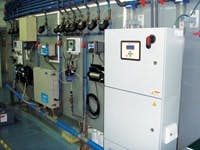In anticipation of the U.S. Environmental Protection Agency’s (EPA) Stage 2 Disinfection Byproduct Rule (DBPR), responsible utilities across the U.S. have invested billions in capital improvements and millions more in ongoing operating expenses. Prudent practice necessitates conservative treatment to ensure trihalomethane (THM) compliance resulting in additional operating expenses, as traditional laboratory analysis of water samples can take up to 10 days, too late for treatment process optimization. The result is a larger environmental footprint and higher production costs.
Using public data from the Congressional Budget Office (CBO) and EPA, this article will review the costs necessary to meet the Stage 2 DBPR and highlight the value of THM monitoring, along with other operational parameters, to enable cost savings related to timing and amounts of source blending, coagulants, flocculants, disinfection agents, activated carbon, energy and other consumables by bringing the process “under control.” With continuous monitoring, any changes in THM levels can be rapidly identified and remediation processes changed accordingly.
Evolution of DBP Regulations
Disinfection byproducts are formed when naturally occurring matter interacts with chlorine-based disinfectants used for microbial disinfection. The health hazards of disinfection byproducts were first identified in the 1970s, when high levels of chloroform were detected in drinking water sourced from the Ohio River. Subsequent analysis showed that chloroform was absent from the river and could only have been produced at the drinking water purification plant.
By the 1970s, it was apparent that chloroform and other THMs represented a cancer risk through chronic exposure. Shortly after the passage of the Safe Drinking Water Act (SDWA) in 1974, EPA first regulated total trihalomethanes (TTHM) in 1979 at 100 parts per billion (ppb) for systems serving at least 10,000 people.
According to EPA’s website, the rule was revised when the agency issued the Stage 1 Disinfectants and Disinfection Byproducts Rule (Stage 1 DBPR) in December 1998. The Stage 1 DBPR was the first phase in a rulemaking strategy required by Congress as part of the 1996 amendments to the SDWA. The Stage 1 DBPR set the maximum contaminant level for TTHM at 80 ppb and for the first time set a maximum contaminant level for five haloacetic acids (HAA5) at 60 ppb. Implementation began at the end of 2002 for surface water systems serving 10,000 or more people and by the end of 2004 for all other systems.
The Stage 2 DBPR was proposed in August 2003 and finalized on Dec. 15, 2005. It will go into effect in 2012.
Industry Impact
During discussions relating to the passage of the Stage 2 DBPR, the CBO issued a report titled, “The Safe Drinking Water Act: A Case Study of an Unfunded Federal Mandate,” a requirement of the Unfunded Mandates Reform Act of 1995, which requires the CBO to estimate the costs of proposed legislation on state and local governments.
With approximately 48,000 utilities out of almost 75,000 utilities in the U.S. assumed to be affected by the Stage 2 DBPR, compliance costs were estimated to exceed $2.6 billion in 1992 dollars. Translating 1992 costs into 2011 dollars by taking into account the U.S. inflation rate over that period, the cost of compliance becomes a staggering $4.2 billion dollars.
Of course, some utilities will be financially unable to comply with the regulations and thus be in violation, while many others will need to spend significantly to upgrade their facilities and assume higher incremental operating costs (chemical treatment and sludge removal, filtration, blending and associated energy costs) needed to operate the upgraded equipment.
In December 2005, as part of its regulatory impact assessment, EPA published a report titled, “Technologies and Costs Document for the Final Long Term 2 Enhanced Surface Water Treatment Rule and Final Stage 2 Disinfectants and Disinfection Byproducts Rule,” which looked at the technologies available to the industry for meeting the Stage 2 DBPR, including ozone, ultraviolet technology, filtration and granular activated carbon.
Current Practice
Regardless of the technology used, each water treatment plant is unique and is designed to accommodate its specific geography, resources and water demands.
A typical water treatment plant monitors a number of parameters, but few plants are able to monitor their disinfection byproducts, such as THMs. A typical laboratory takes seven to 10 business days to return results, so it is like driving a car without a speedometer, waiting for the speed camera pictures to modify the process. By the time the results are received from the lab, the underlying parameters could have changed.
Consequently, water utilities are forced to operate their facilities more conservatively, resulting in more spending on chemicals, sludge removal, processing, power and other resources than necessary, generating a much larger environmental footprint and higher production costs. Alternatively, the water treatment plant could be out of compliance without even knowing it.
Modern Tools
Fortunately, there are now several systems on the market that allow utilities to directly measure their THM levels and thus provide feedback to their water production process, allowing them to manage Stage 2 DBPR compliance.
A possible solution is the AMS THM-100 system, which specializes in streamlining the processes involved during the treatment and production of drinking water. It is a is self-calibrating system, which is designed for continuous, unattendedoperation. Monitoring results are delivered over 4-20 mA via the utility’s SCADA system to the customer’s HMI.
Potential Savings Impact
These types of systems offer significant savings. Using the figures from the EPA report, for an “average” 100-million-gal-per-day water treatment plant already in compliance, a 5% savings from process efficiency represents a savings of $500,000 per year from energy and chemical savings alone.
Although many other factors, such as odor, color, turbidity and contact time, influence process selection and parameters at a water treatment plant, significant potential savings can be realized via the addition of online THM monitoring—enough to pay for the equipment and buy peace of mind.


